UCD HRM3007S: Talent Management Report for Atlanta Inn in Singapore
VerifiedAdded on 2022/12/27
|19
|4359
|57
Report
AI Summary
This report provides a comprehensive analysis of talent management strategies, focusing on the case of Atlanta Inn and its expansion into Singapore. It begins with an introduction to talent management, emphasizing its importance in aligning human resources with business objectives. The report then delves into the significance of a robust talent management strategy, highlighting its role in attracting and retaining top talent, enhancing employee motivation and performance, and improving overall business outcomes. It contrasts these benefits with the consequences of neglecting talent management, such as missed opportunities, increased costs associated with poor hiring decisions, and reduced employee engagement. The core of the report involves the development of a talent management policy tailored for Atlanta Inn's Singapore operations, covering key human resource practices like talent acquisition, retention, selection, and employee development. The policy outlines the company's approach to high-performance standards, work level expectations, talent review processes, and talent identification, along with the underlying principles and responsibilities. The report concludes by summarizing the key findings and recommendations for successful talent management implementation.
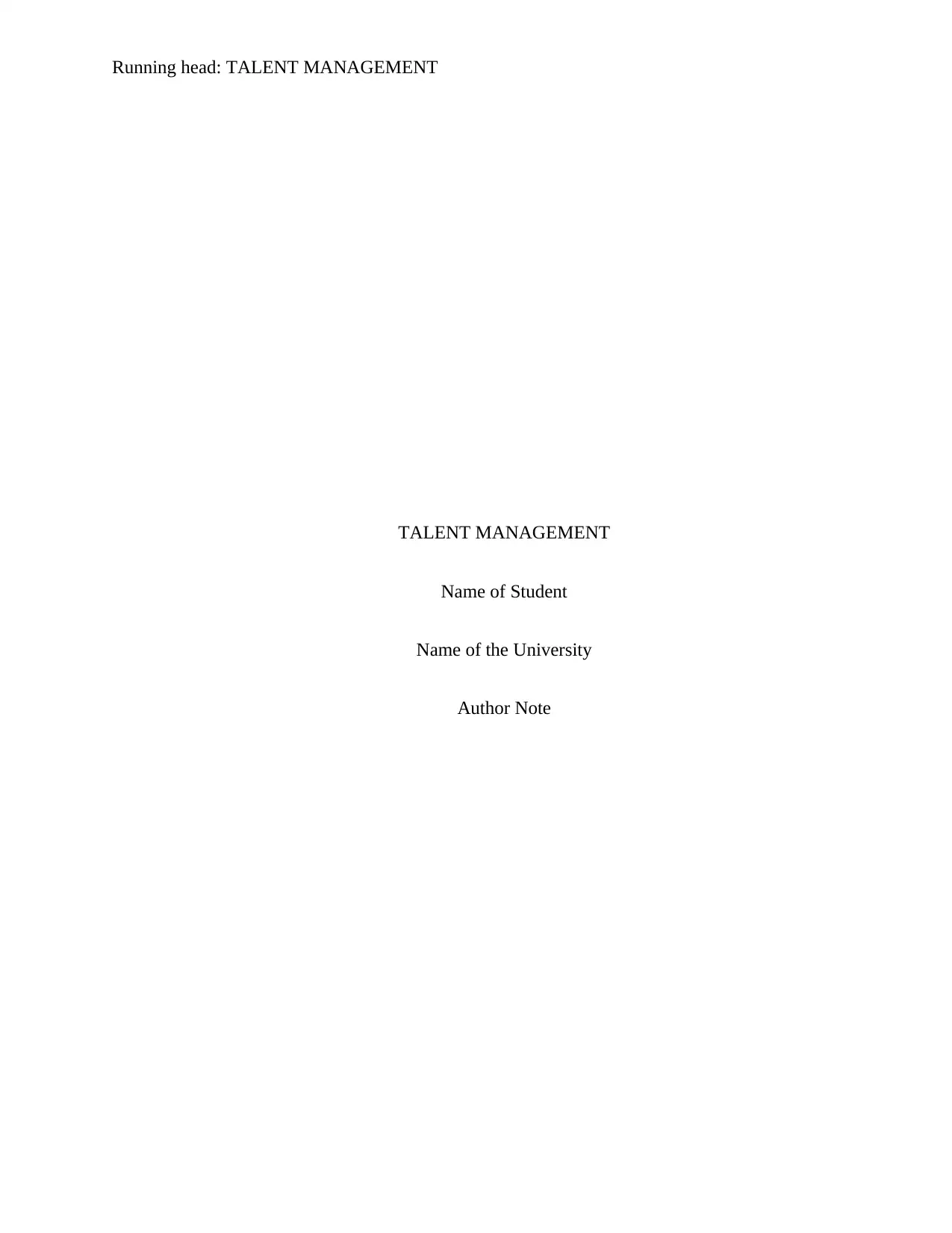
Running head: TALENT MANAGEMENT
TALENT MANAGEMENT
Name of Student
Name of the University
Author Note
TALENT MANAGEMENT
Name of Student
Name of the University
Author Note
Paraphrase This Document
Need a fresh take? Get an instant paraphrase of this document with our AI Paraphraser
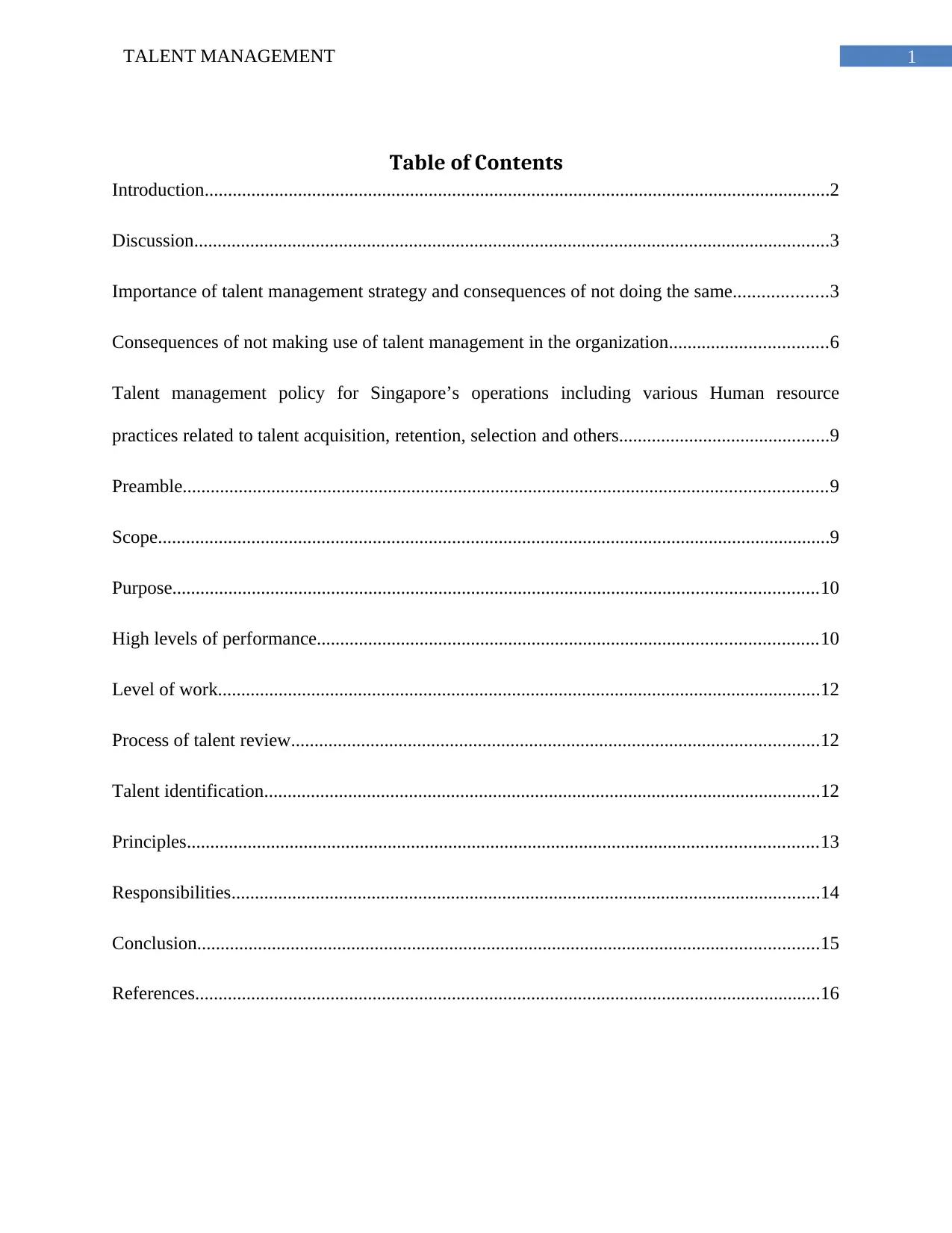
1TALENT MANAGEMENT
Table of Contents
Introduction......................................................................................................................................2
Discussion........................................................................................................................................3
Importance of talent management strategy and consequences of not doing the same....................3
Consequences of not making use of talent management in the organization..................................6
Talent management policy for Singapore’s operations including various Human resource
practices related to talent acquisition, retention, selection and others.............................................9
Preamble..........................................................................................................................................9
Scope................................................................................................................................................9
Purpose..........................................................................................................................................10
High levels of performance...........................................................................................................10
Level of work.................................................................................................................................12
Process of talent review.................................................................................................................12
Talent identification.......................................................................................................................12
Principles.......................................................................................................................................13
Responsibilities..............................................................................................................................14
Conclusion.....................................................................................................................................15
References......................................................................................................................................16
Table of Contents
Introduction......................................................................................................................................2
Discussion........................................................................................................................................3
Importance of talent management strategy and consequences of not doing the same....................3
Consequences of not making use of talent management in the organization..................................6
Talent management policy for Singapore’s operations including various Human resource
practices related to talent acquisition, retention, selection and others.............................................9
Preamble..........................................................................................................................................9
Scope................................................................................................................................................9
Purpose..........................................................................................................................................10
High levels of performance...........................................................................................................10
Level of work.................................................................................................................................12
Process of talent review.................................................................................................................12
Talent identification.......................................................................................................................12
Principles.......................................................................................................................................13
Responsibilities..............................................................................................................................14
Conclusion.....................................................................................................................................15
References......................................................................................................................................16
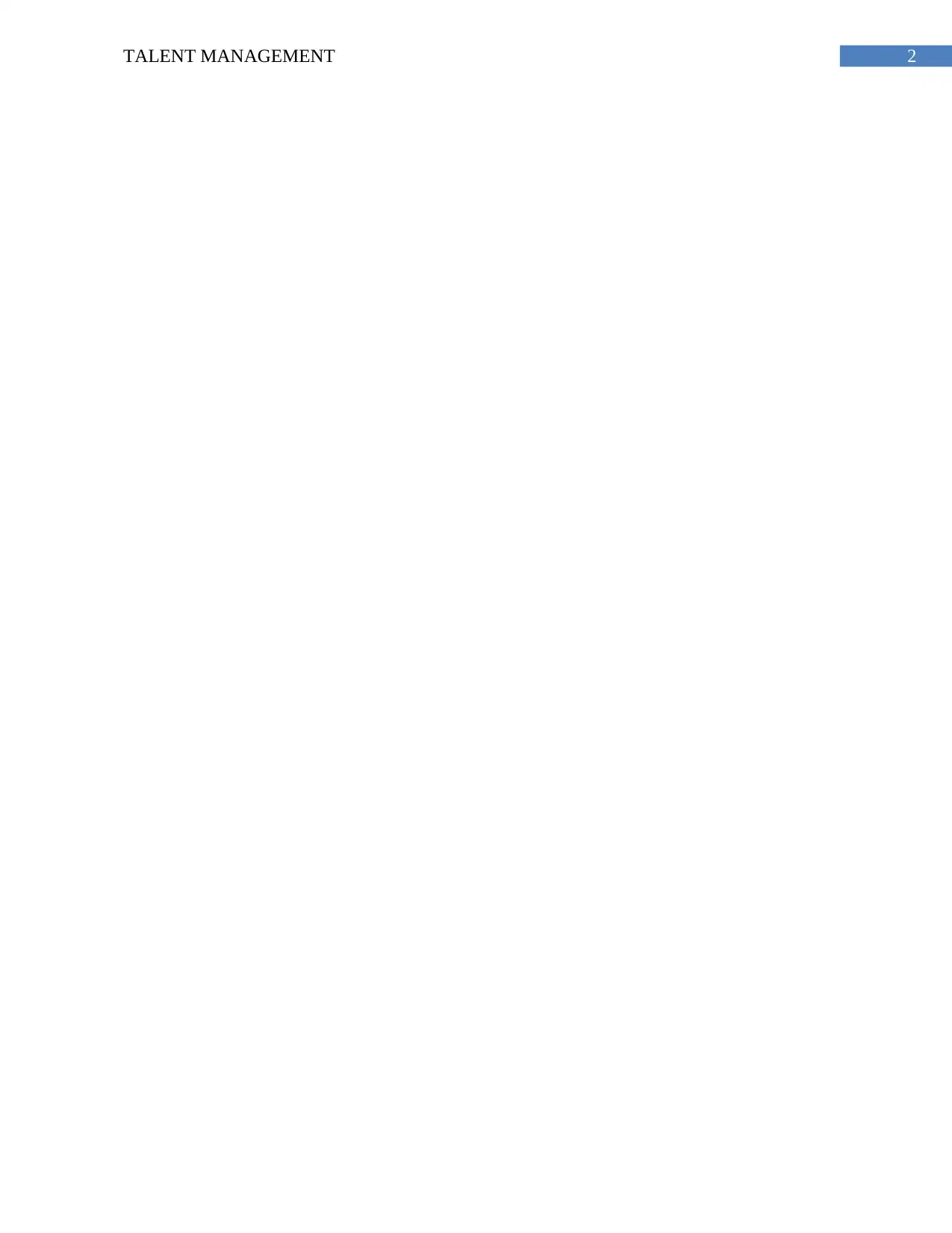
2TALENT MANAGEMENT
⊘ This is a preview!⊘
Do you want full access?
Subscribe today to unlock all pages.

Trusted by 1+ million students worldwide
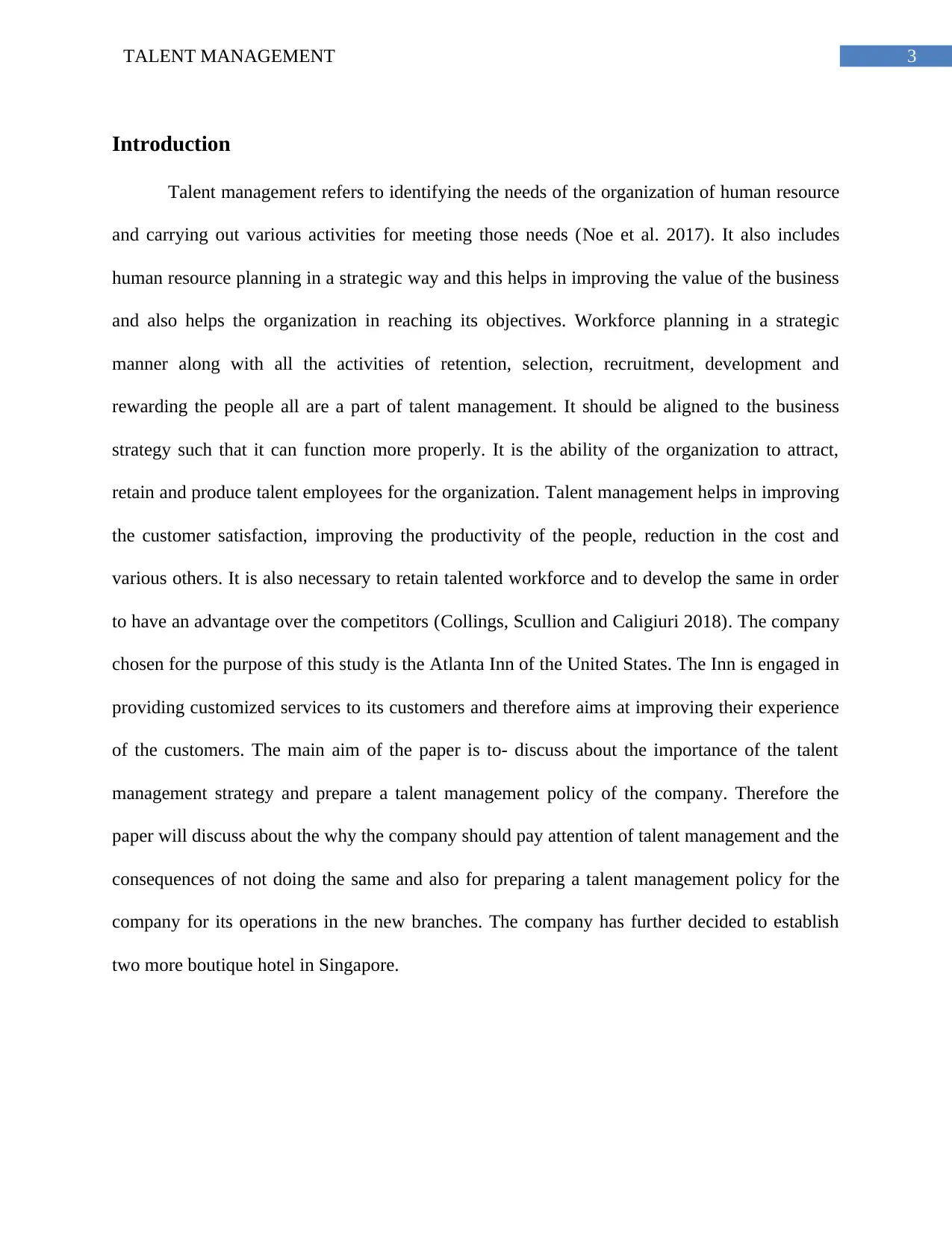
3TALENT MANAGEMENT
Introduction
Talent management refers to identifying the needs of the organization of human resource
and carrying out various activities for meeting those needs (Noe et al. 2017). It also includes
human resource planning in a strategic way and this helps in improving the value of the business
and also helps the organization in reaching its objectives. Workforce planning in a strategic
manner along with all the activities of retention, selection, recruitment, development and
rewarding the people all are a part of talent management. It should be aligned to the business
strategy such that it can function more properly. It is the ability of the organization to attract,
retain and produce talent employees for the organization. Talent management helps in improving
the customer satisfaction, improving the productivity of the people, reduction in the cost and
various others. It is also necessary to retain talented workforce and to develop the same in order
to have an advantage over the competitors (Collings, Scullion and Caligiuri 2018). The company
chosen for the purpose of this study is the Atlanta Inn of the United States. The Inn is engaged in
providing customized services to its customers and therefore aims at improving their experience
of the customers. The main aim of the paper is to- discuss about the importance of the talent
management strategy and prepare a talent management policy of the company. Therefore the
paper will discuss about the why the company should pay attention of talent management and the
consequences of not doing the same and also for preparing a talent management policy for the
company for its operations in the new branches. The company has further decided to establish
two more boutique hotel in Singapore.
Introduction
Talent management refers to identifying the needs of the organization of human resource
and carrying out various activities for meeting those needs (Noe et al. 2017). It also includes
human resource planning in a strategic way and this helps in improving the value of the business
and also helps the organization in reaching its objectives. Workforce planning in a strategic
manner along with all the activities of retention, selection, recruitment, development and
rewarding the people all are a part of talent management. It should be aligned to the business
strategy such that it can function more properly. It is the ability of the organization to attract,
retain and produce talent employees for the organization. Talent management helps in improving
the customer satisfaction, improving the productivity of the people, reduction in the cost and
various others. It is also necessary to retain talented workforce and to develop the same in order
to have an advantage over the competitors (Collings, Scullion and Caligiuri 2018). The company
chosen for the purpose of this study is the Atlanta Inn of the United States. The Inn is engaged in
providing customized services to its customers and therefore aims at improving their experience
of the customers. The main aim of the paper is to- discuss about the importance of the talent
management strategy and prepare a talent management policy of the company. Therefore the
paper will discuss about the why the company should pay attention of talent management and the
consequences of not doing the same and also for preparing a talent management policy for the
company for its operations in the new branches. The company has further decided to establish
two more boutique hotel in Singapore.
Paraphrase This Document
Need a fresh take? Get an instant paraphrase of this document with our AI Paraphraser
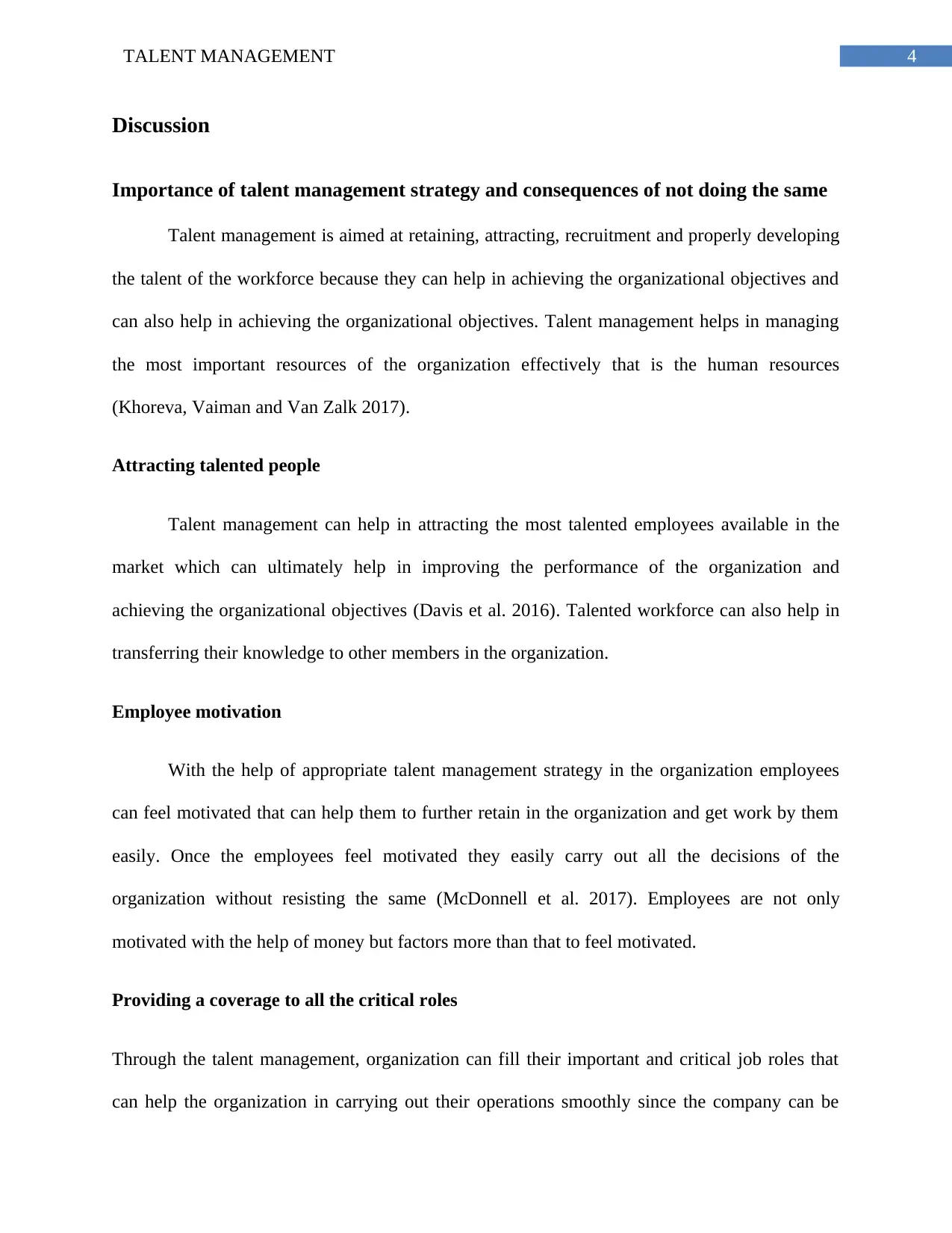
4TALENT MANAGEMENT
Discussion
Importance of talent management strategy and consequences of not doing the same
Talent management is aimed at retaining, attracting, recruitment and properly developing
the talent of the workforce because they can help in achieving the organizational objectives and
can also help in achieving the organizational objectives. Talent management helps in managing
the most important resources of the organization effectively that is the human resources
(Khoreva, Vaiman and Van Zalk 2017).
Attracting talented people
Talent management can help in attracting the most talented employees available in the
market which can ultimately help in improving the performance of the organization and
achieving the organizational objectives (Davis et al. 2016). Talented workforce can also help in
transferring their knowledge to other members in the organization.
Employee motivation
With the help of appropriate talent management strategy in the organization employees
can feel motivated that can help them to further retain in the organization and get work by them
easily. Once the employees feel motivated they easily carry out all the decisions of the
organization without resisting the same (McDonnell et al. 2017). Employees are not only
motivated with the help of money but factors more than that to feel motivated.
Providing a coverage to all the critical roles
Through the talent management, organization can fill their important and critical job roles that
can help the organization in carrying out their operations smoothly since the company can be
Discussion
Importance of talent management strategy and consequences of not doing the same
Talent management is aimed at retaining, attracting, recruitment and properly developing
the talent of the workforce because they can help in achieving the organizational objectives and
can also help in achieving the organizational objectives. Talent management helps in managing
the most important resources of the organization effectively that is the human resources
(Khoreva, Vaiman and Van Zalk 2017).
Attracting talented people
Talent management can help in attracting the most talented employees available in the
market which can ultimately help in improving the performance of the organization and
achieving the organizational objectives (Davis et al. 2016). Talented workforce can also help in
transferring their knowledge to other members in the organization.
Employee motivation
With the help of appropriate talent management strategy in the organization employees
can feel motivated that can help them to further retain in the organization and get work by them
easily. Once the employees feel motivated they easily carry out all the decisions of the
organization without resisting the same (McDonnell et al. 2017). Employees are not only
motivated with the help of money but factors more than that to feel motivated.
Providing a coverage to all the critical roles
Through the talent management, organization can fill their important and critical job roles that
can help the organization in carrying out their operations smoothly since the company can be
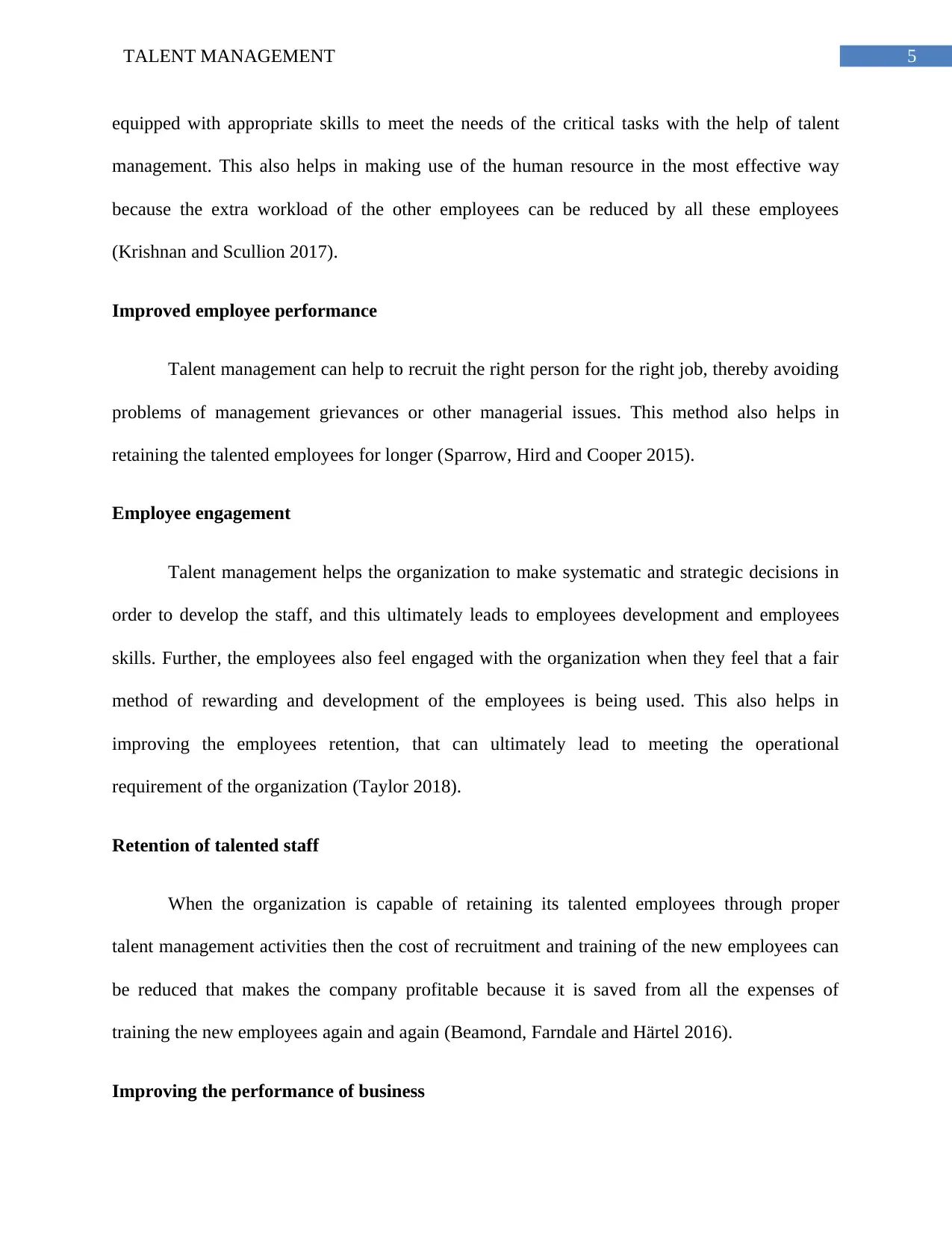
5TALENT MANAGEMENT
equipped with appropriate skills to meet the needs of the critical tasks with the help of talent
management. This also helps in making use of the human resource in the most effective way
because the extra workload of the other employees can be reduced by all these employees
(Krishnan and Scullion 2017).
Improved employee performance
Talent management can help to recruit the right person for the right job, thereby avoiding
problems of management grievances or other managerial issues. This method also helps in
retaining the talented employees for longer (Sparrow, Hird and Cooper 2015).
Employee engagement
Talent management helps the organization to make systematic and strategic decisions in
order to develop the staff, and this ultimately leads to employees development and employees
skills. Further, the employees also feel engaged with the organization when they feel that a fair
method of rewarding and development of the employees is being used. This also helps in
improving the employees retention, that can ultimately lead to meeting the operational
requirement of the organization (Taylor 2018).
Retention of talented staff
When the organization is capable of retaining its talented employees through proper
talent management activities then the cost of recruitment and training of the new employees can
be reduced that makes the company profitable because it is saved from all the expenses of
training the new employees again and again (Beamond, Farndale and Härtel 2016).
Improving the performance of business
equipped with appropriate skills to meet the needs of the critical tasks with the help of talent
management. This also helps in making use of the human resource in the most effective way
because the extra workload of the other employees can be reduced by all these employees
(Krishnan and Scullion 2017).
Improved employee performance
Talent management can help to recruit the right person for the right job, thereby avoiding
problems of management grievances or other managerial issues. This method also helps in
retaining the talented employees for longer (Sparrow, Hird and Cooper 2015).
Employee engagement
Talent management helps the organization to make systematic and strategic decisions in
order to develop the staff, and this ultimately leads to employees development and employees
skills. Further, the employees also feel engaged with the organization when they feel that a fair
method of rewarding and development of the employees is being used. This also helps in
improving the employees retention, that can ultimately lead to meeting the operational
requirement of the organization (Taylor 2018).
Retention of talented staff
When the organization is capable of retaining its talented employees through proper
talent management activities then the cost of recruitment and training of the new employees can
be reduced that makes the company profitable because it is saved from all the expenses of
training the new employees again and again (Beamond, Farndale and Härtel 2016).
Improving the performance of business
⊘ This is a preview!⊘
Do you want full access?
Subscribe today to unlock all pages.

Trusted by 1+ million students worldwide
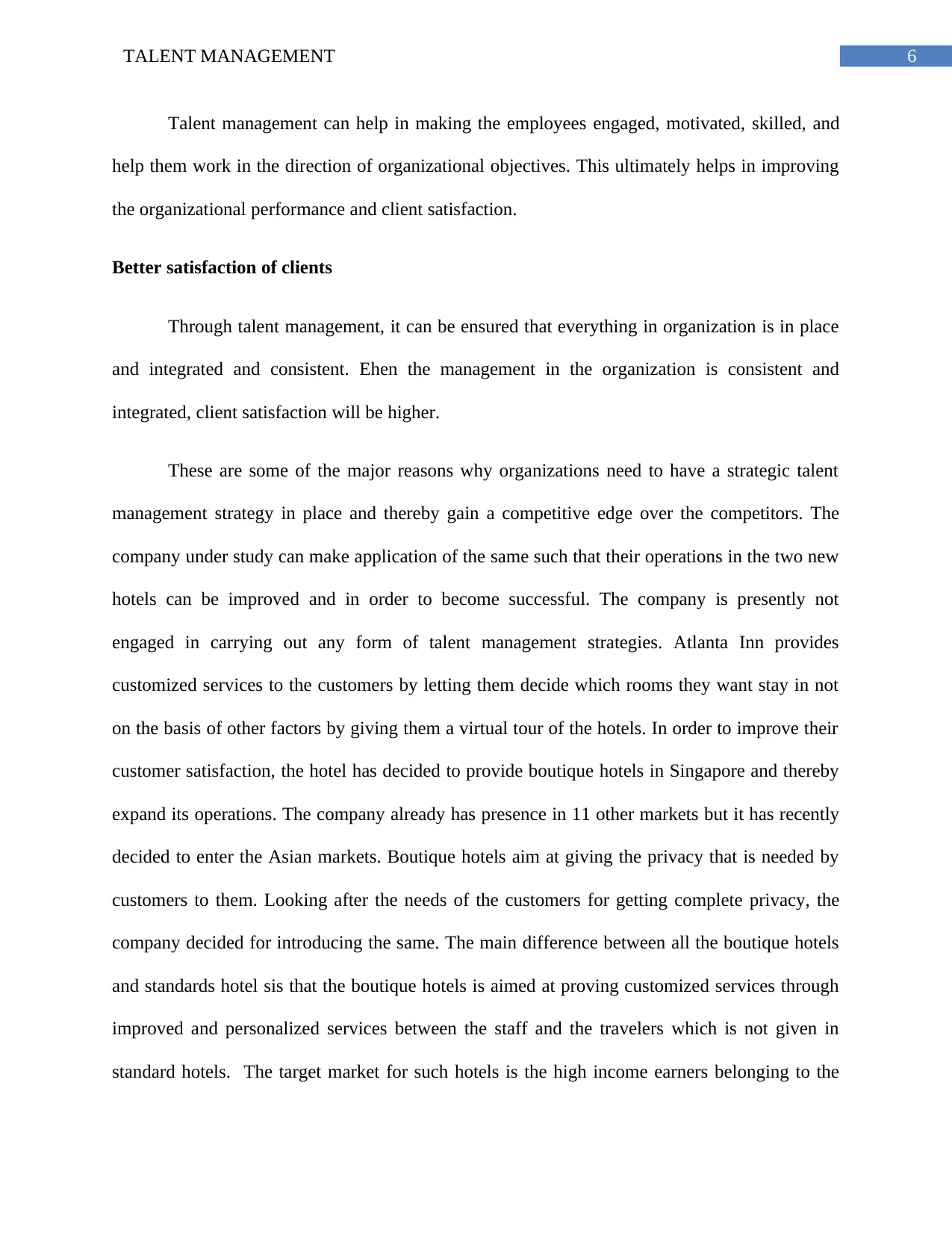
6TALENT MANAGEMENT
Talent management can help in making the employees engaged, motivated, skilled, and
help them work in the direction of organizational objectives. This ultimately helps in improving
the organizational performance and client satisfaction.
Better satisfaction of clients
Through talent management, it can be ensured that everything in organization is in place
and integrated and consistent. Ehen the management in the organization is consistent and
integrated, client satisfaction will be higher.
These are some of the major reasons why organizations need to have a strategic talent
management strategy in place and thereby gain a competitive edge over the competitors. The
company under study can make application of the same such that their operations in the two new
hotels can be improved and in order to become successful. The company is presently not
engaged in carrying out any form of talent management strategies. Atlanta Inn provides
customized services to the customers by letting them decide which rooms they want stay in not
on the basis of other factors by giving them a virtual tour of the hotels. In order to improve their
customer satisfaction, the hotel has decided to provide boutique hotels in Singapore and thereby
expand its operations. The company already has presence in 11 other markets but it has recently
decided to enter the Asian markets. Boutique hotels aim at giving the privacy that is needed by
customers to them. Looking after the needs of the customers for getting complete privacy, the
company decided for introducing the same. The main difference between all the boutique hotels
and standards hotel sis that the boutique hotels is aimed at proving customized services through
improved and personalized services between the staff and the travelers which is not given in
standard hotels. The target market for such hotels is the high income earners belonging to the
Talent management can help in making the employees engaged, motivated, skilled, and
help them work in the direction of organizational objectives. This ultimately helps in improving
the organizational performance and client satisfaction.
Better satisfaction of clients
Through talent management, it can be ensured that everything in organization is in place
and integrated and consistent. Ehen the management in the organization is consistent and
integrated, client satisfaction will be higher.
These are some of the major reasons why organizations need to have a strategic talent
management strategy in place and thereby gain a competitive edge over the competitors. The
company under study can make application of the same such that their operations in the two new
hotels can be improved and in order to become successful. The company is presently not
engaged in carrying out any form of talent management strategies. Atlanta Inn provides
customized services to the customers by letting them decide which rooms they want stay in not
on the basis of other factors by giving them a virtual tour of the hotels. In order to improve their
customer satisfaction, the hotel has decided to provide boutique hotels in Singapore and thereby
expand its operations. The company already has presence in 11 other markets but it has recently
decided to enter the Asian markets. Boutique hotels aim at giving the privacy that is needed by
customers to them. Looking after the needs of the customers for getting complete privacy, the
company decided for introducing the same. The main difference between all the boutique hotels
and standards hotel sis that the boutique hotels is aimed at proving customized services through
improved and personalized services between the staff and the travelers which is not given in
standard hotels. The target market for such hotels is the high income earners belonging to the
Paraphrase This Document
Need a fresh take? Get an instant paraphrase of this document with our AI Paraphraser
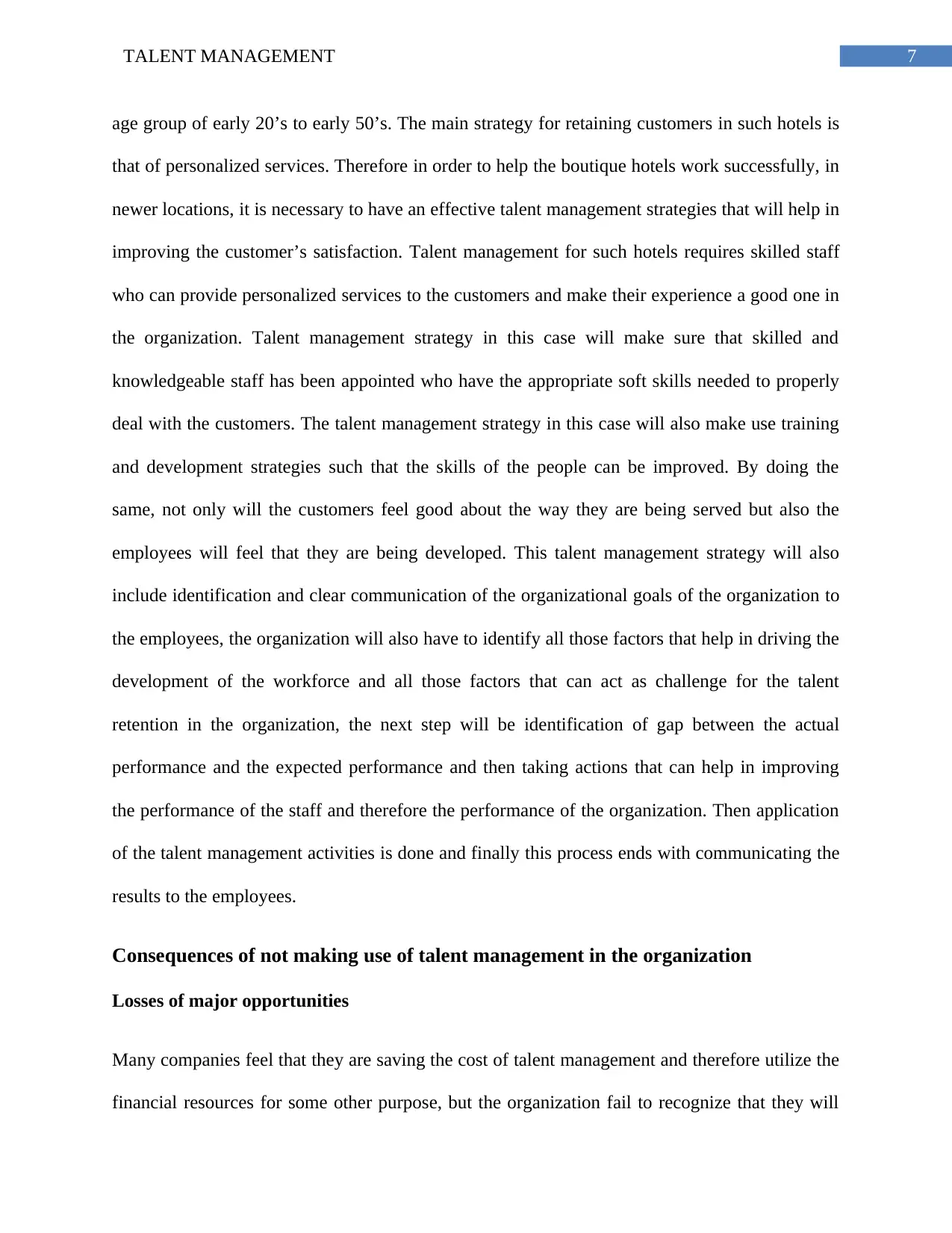
7TALENT MANAGEMENT
age group of early 20’s to early 50’s. The main strategy for retaining customers in such hotels is
that of personalized services. Therefore in order to help the boutique hotels work successfully, in
newer locations, it is necessary to have an effective talent management strategies that will help in
improving the customer’s satisfaction. Talent management for such hotels requires skilled staff
who can provide personalized services to the customers and make their experience a good one in
the organization. Talent management strategy in this case will make sure that skilled and
knowledgeable staff has been appointed who have the appropriate soft skills needed to properly
deal with the customers. The talent management strategy in this case will also make use training
and development strategies such that the skills of the people can be improved. By doing the
same, not only will the customers feel good about the way they are being served but also the
employees will feel that they are being developed. This talent management strategy will also
include identification and clear communication of the organizational goals of the organization to
the employees, the organization will also have to identify all those factors that help in driving the
development of the workforce and all those factors that can act as challenge for the talent
retention in the organization, the next step will be identification of gap between the actual
performance and the expected performance and then taking actions that can help in improving
the performance of the staff and therefore the performance of the organization. Then application
of the talent management activities is done and finally this process ends with communicating the
results to the employees.
Consequences of not making use of talent management in the organization
Losses of major opportunities
Many companies feel that they are saving the cost of talent management and therefore utilize the
financial resources for some other purpose, but the organization fail to recognize that they will
age group of early 20’s to early 50’s. The main strategy for retaining customers in such hotels is
that of personalized services. Therefore in order to help the boutique hotels work successfully, in
newer locations, it is necessary to have an effective talent management strategies that will help in
improving the customer’s satisfaction. Talent management for such hotels requires skilled staff
who can provide personalized services to the customers and make their experience a good one in
the organization. Talent management strategy in this case will make sure that skilled and
knowledgeable staff has been appointed who have the appropriate soft skills needed to properly
deal with the customers. The talent management strategy in this case will also make use training
and development strategies such that the skills of the people can be improved. By doing the
same, not only will the customers feel good about the way they are being served but also the
employees will feel that they are being developed. This talent management strategy will also
include identification and clear communication of the organizational goals of the organization to
the employees, the organization will also have to identify all those factors that help in driving the
development of the workforce and all those factors that can act as challenge for the talent
retention in the organization, the next step will be identification of gap between the actual
performance and the expected performance and then taking actions that can help in improving
the performance of the staff and therefore the performance of the organization. Then application
of the talent management activities is done and finally this process ends with communicating the
results to the employees.
Consequences of not making use of talent management in the organization
Losses of major opportunities
Many companies feel that they are saving the cost of talent management and therefore utilize the
financial resources for some other purpose, but the organization fail to recognize that they will
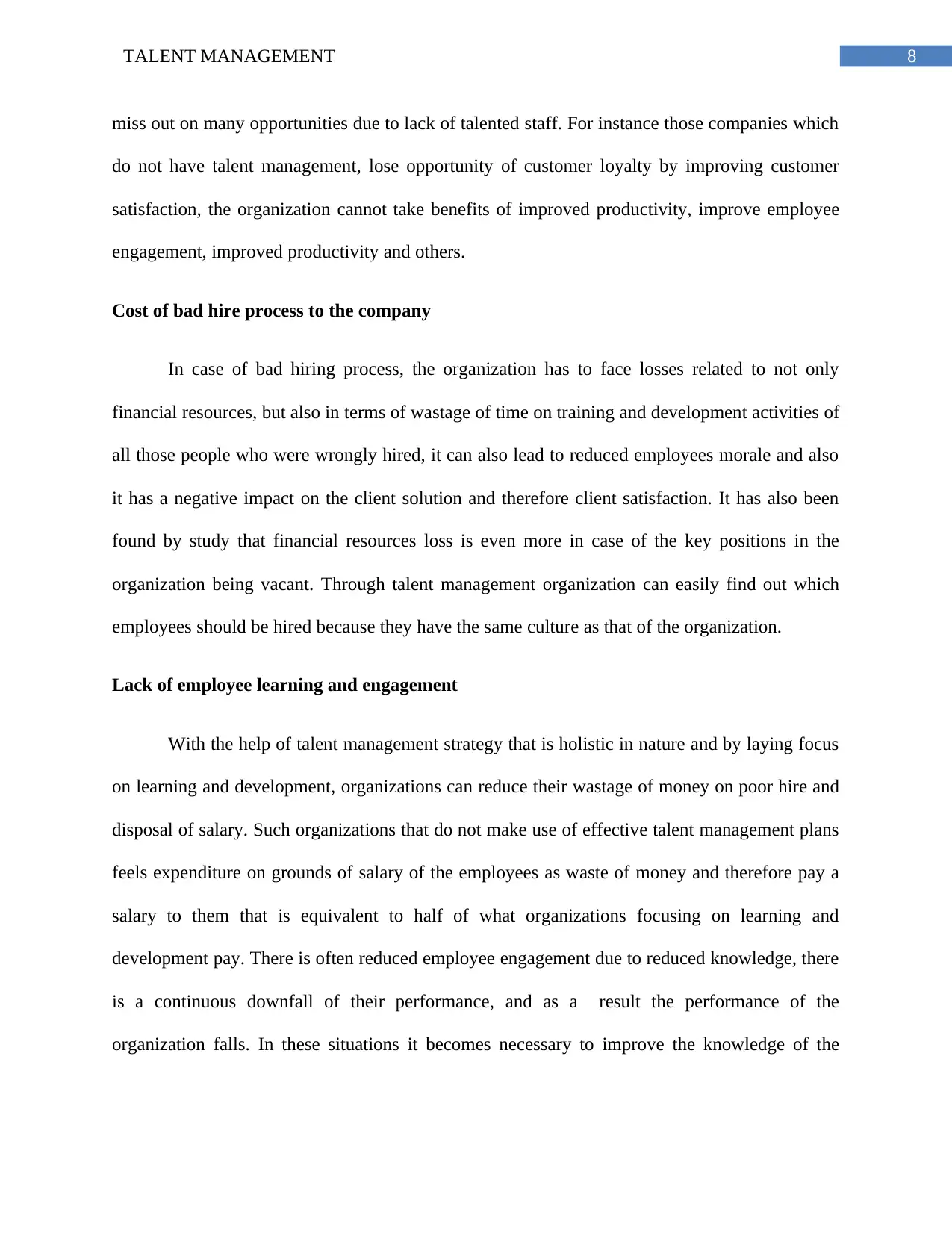
8TALENT MANAGEMENT
miss out on many opportunities due to lack of talented staff. For instance those companies which
do not have talent management, lose opportunity of customer loyalty by improving customer
satisfaction, the organization cannot take benefits of improved productivity, improve employee
engagement, improved productivity and others.
Cost of bad hire process to the company
In case of bad hiring process, the organization has to face losses related to not only
financial resources, but also in terms of wastage of time on training and development activities of
all those people who were wrongly hired, it can also lead to reduced employees morale and also
it has a negative impact on the client solution and therefore client satisfaction. It has also been
found by study that financial resources loss is even more in case of the key positions in the
organization being vacant. Through talent management organization can easily find out which
employees should be hired because they have the same culture as that of the organization.
Lack of employee learning and engagement
With the help of talent management strategy that is holistic in nature and by laying focus
on learning and development, organizations can reduce their wastage of money on poor hire and
disposal of salary. Such organizations that do not make use of effective talent management plans
feels expenditure on grounds of salary of the employees as waste of money and therefore pay a
salary to them that is equivalent to half of what organizations focusing on learning and
development pay. There is often reduced employee engagement due to reduced knowledge, there
is a continuous downfall of their performance, and as a result the performance of the
organization falls. In these situations it becomes necessary to improve the knowledge of the
miss out on many opportunities due to lack of talented staff. For instance those companies which
do not have talent management, lose opportunity of customer loyalty by improving customer
satisfaction, the organization cannot take benefits of improved productivity, improve employee
engagement, improved productivity and others.
Cost of bad hire process to the company
In case of bad hiring process, the organization has to face losses related to not only
financial resources, but also in terms of wastage of time on training and development activities of
all those people who were wrongly hired, it can also lead to reduced employees morale and also
it has a negative impact on the client solution and therefore client satisfaction. It has also been
found by study that financial resources loss is even more in case of the key positions in the
organization being vacant. Through talent management organization can easily find out which
employees should be hired because they have the same culture as that of the organization.
Lack of employee learning and engagement
With the help of talent management strategy that is holistic in nature and by laying focus
on learning and development, organizations can reduce their wastage of money on poor hire and
disposal of salary. Such organizations that do not make use of effective talent management plans
feels expenditure on grounds of salary of the employees as waste of money and therefore pay a
salary to them that is equivalent to half of what organizations focusing on learning and
development pay. There is often reduced employee engagement due to reduced knowledge, there
is a continuous downfall of their performance, and as a result the performance of the
organization falls. In these situations it becomes necessary to improve the knowledge of the
⊘ This is a preview!⊘
Do you want full access?
Subscribe today to unlock all pages.

Trusted by 1+ million students worldwide
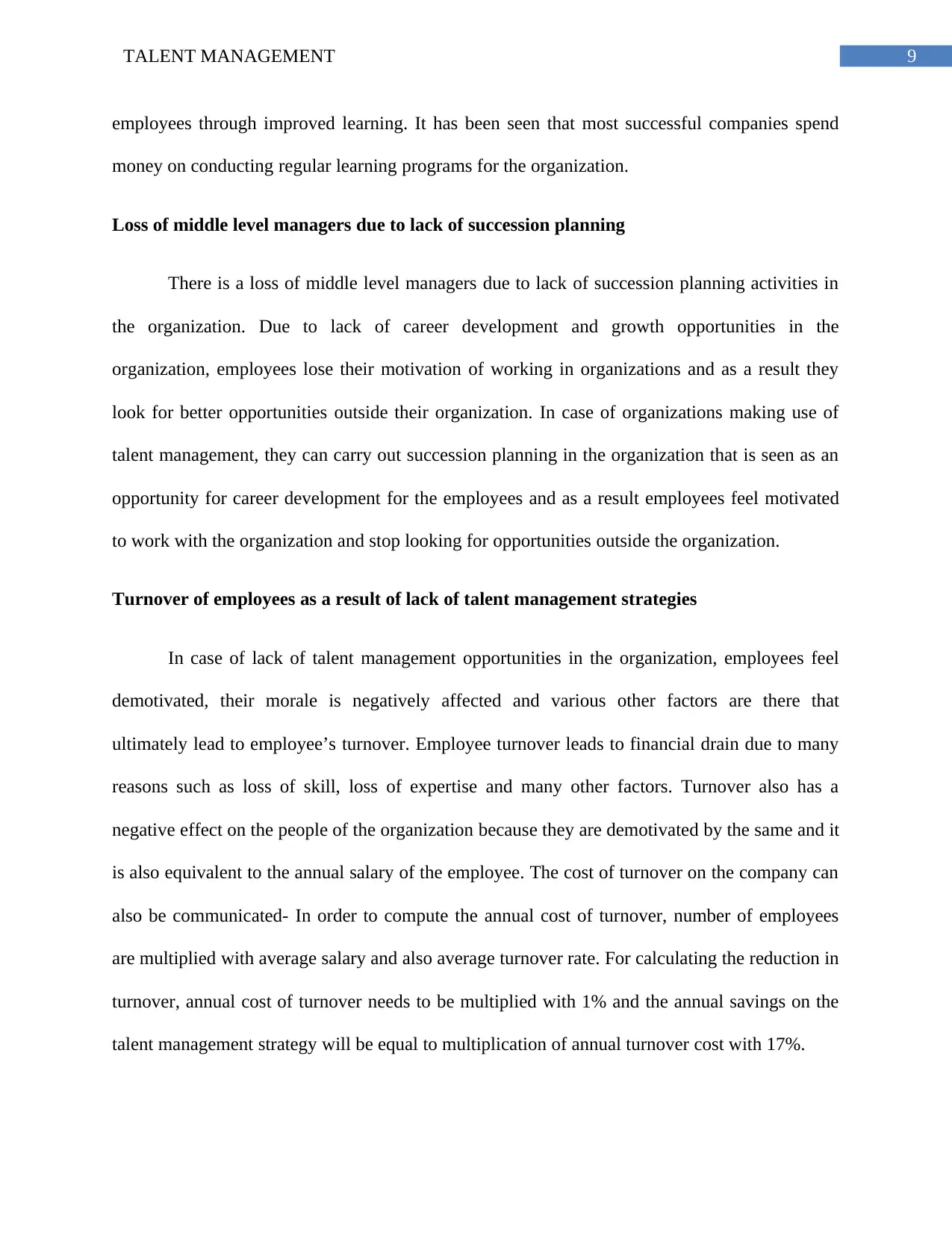
9TALENT MANAGEMENT
employees through improved learning. It has been seen that most successful companies spend
money on conducting regular learning programs for the organization.
Loss of middle level managers due to lack of succession planning
There is a loss of middle level managers due to lack of succession planning activities in
the organization. Due to lack of career development and growth opportunities in the
organization, employees lose their motivation of working in organizations and as a result they
look for better opportunities outside their organization. In case of organizations making use of
talent management, they can carry out succession planning in the organization that is seen as an
opportunity for career development for the employees and as a result employees feel motivated
to work with the organization and stop looking for opportunities outside the organization.
Turnover of employees as a result of lack of talent management strategies
In case of lack of talent management opportunities in the organization, employees feel
demotivated, their morale is negatively affected and various other factors are there that
ultimately lead to employee’s turnover. Employee turnover leads to financial drain due to many
reasons such as loss of skill, loss of expertise and many other factors. Turnover also has a
negative effect on the people of the organization because they are demotivated by the same and it
is also equivalent to the annual salary of the employee. The cost of turnover on the company can
also be communicated- In order to compute the annual cost of turnover, number of employees
are multiplied with average salary and also average turnover rate. For calculating the reduction in
turnover, annual cost of turnover needs to be multiplied with 1% and the annual savings on the
talent management strategy will be equal to multiplication of annual turnover cost with 17%.
employees through improved learning. It has been seen that most successful companies spend
money on conducting regular learning programs for the organization.
Loss of middle level managers due to lack of succession planning
There is a loss of middle level managers due to lack of succession planning activities in
the organization. Due to lack of career development and growth opportunities in the
organization, employees lose their motivation of working in organizations and as a result they
look for better opportunities outside their organization. In case of organizations making use of
talent management, they can carry out succession planning in the organization that is seen as an
opportunity for career development for the employees and as a result employees feel motivated
to work with the organization and stop looking for opportunities outside the organization.
Turnover of employees as a result of lack of talent management strategies
In case of lack of talent management opportunities in the organization, employees feel
demotivated, their morale is negatively affected and various other factors are there that
ultimately lead to employee’s turnover. Employee turnover leads to financial drain due to many
reasons such as loss of skill, loss of expertise and many other factors. Turnover also has a
negative effect on the people of the organization because they are demotivated by the same and it
is also equivalent to the annual salary of the employee. The cost of turnover on the company can
also be communicated- In order to compute the annual cost of turnover, number of employees
are multiplied with average salary and also average turnover rate. For calculating the reduction in
turnover, annual cost of turnover needs to be multiplied with 1% and the annual savings on the
talent management strategy will be equal to multiplication of annual turnover cost with 17%.
Paraphrase This Document
Need a fresh take? Get an instant paraphrase of this document with our AI Paraphraser
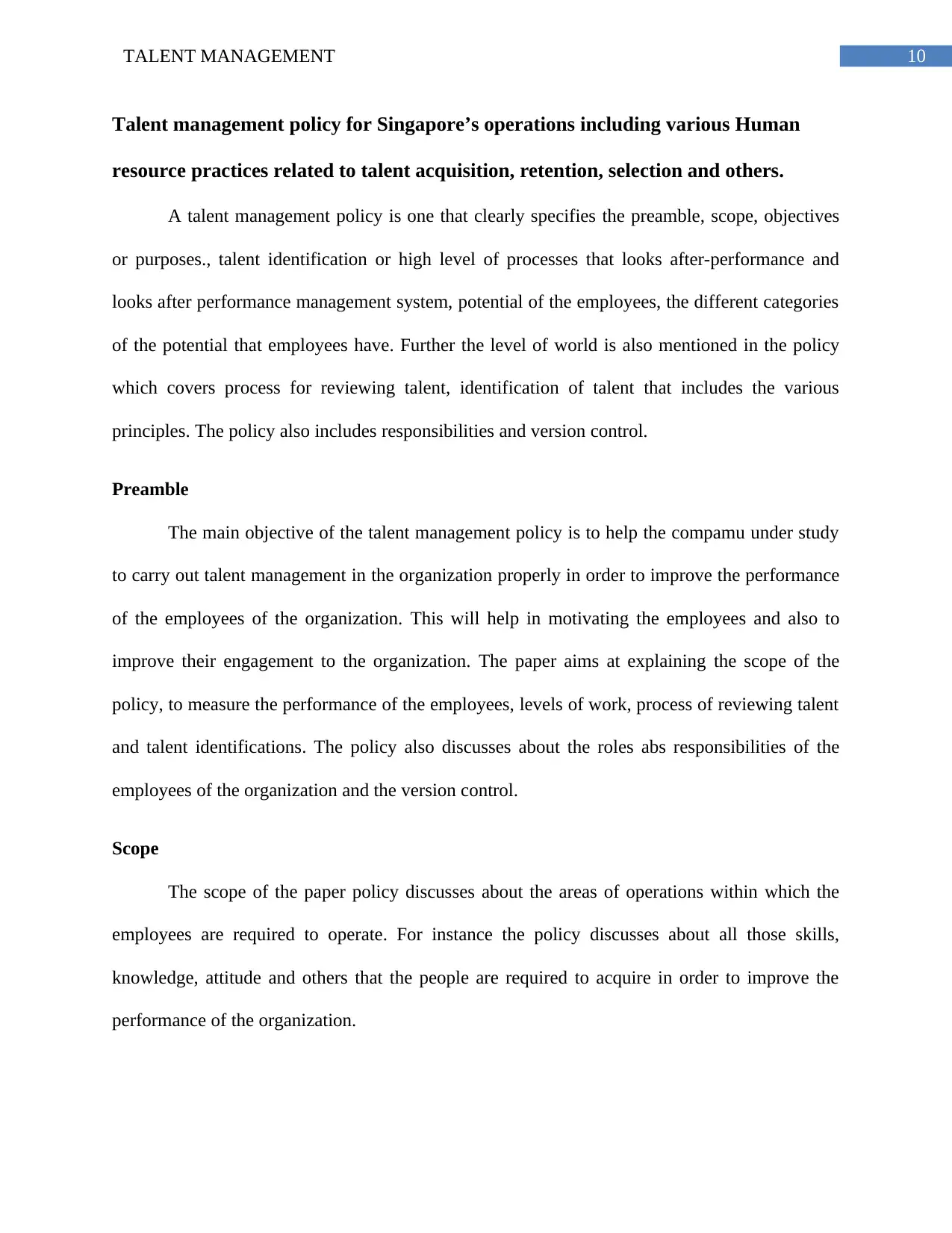
10TALENT MANAGEMENT
Talent management policy for Singapore’s operations including various Human
resource practices related to talent acquisition, retention, selection and others.
A talent management policy is one that clearly specifies the preamble, scope, objectives
or purposes., talent identification or high level of processes that looks after-performance and
looks after performance management system, potential of the employees, the different categories
of the potential that employees have. Further the level of world is also mentioned in the policy
which covers process for reviewing talent, identification of talent that includes the various
principles. The policy also includes responsibilities and version control.
Preamble
The main objective of the talent management policy is to help the compamu under study
to carry out talent management in the organization properly in order to improve the performance
of the employees of the organization. This will help in motivating the employees and also to
improve their engagement to the organization. The paper aims at explaining the scope of the
policy, to measure the performance of the employees, levels of work, process of reviewing talent
and talent identifications. The policy also discusses about the roles abs responsibilities of the
employees of the organization and the version control.
Scope
The scope of the paper policy discusses about the areas of operations within which the
employees are required to operate. For instance the policy discusses about all those skills,
knowledge, attitude and others that the people are required to acquire in order to improve the
performance of the organization.
Talent management policy for Singapore’s operations including various Human
resource practices related to talent acquisition, retention, selection and others.
A talent management policy is one that clearly specifies the preamble, scope, objectives
or purposes., talent identification or high level of processes that looks after-performance and
looks after performance management system, potential of the employees, the different categories
of the potential that employees have. Further the level of world is also mentioned in the policy
which covers process for reviewing talent, identification of talent that includes the various
principles. The policy also includes responsibilities and version control.
Preamble
The main objective of the talent management policy is to help the compamu under study
to carry out talent management in the organization properly in order to improve the performance
of the employees of the organization. This will help in motivating the employees and also to
improve their engagement to the organization. The paper aims at explaining the scope of the
policy, to measure the performance of the employees, levels of work, process of reviewing talent
and talent identifications. The policy also discusses about the roles abs responsibilities of the
employees of the organization and the version control.
Scope
The scope of the paper policy discusses about the areas of operations within which the
employees are required to operate. For instance the policy discusses about all those skills,
knowledge, attitude and others that the people are required to acquire in order to improve the
performance of the organization.
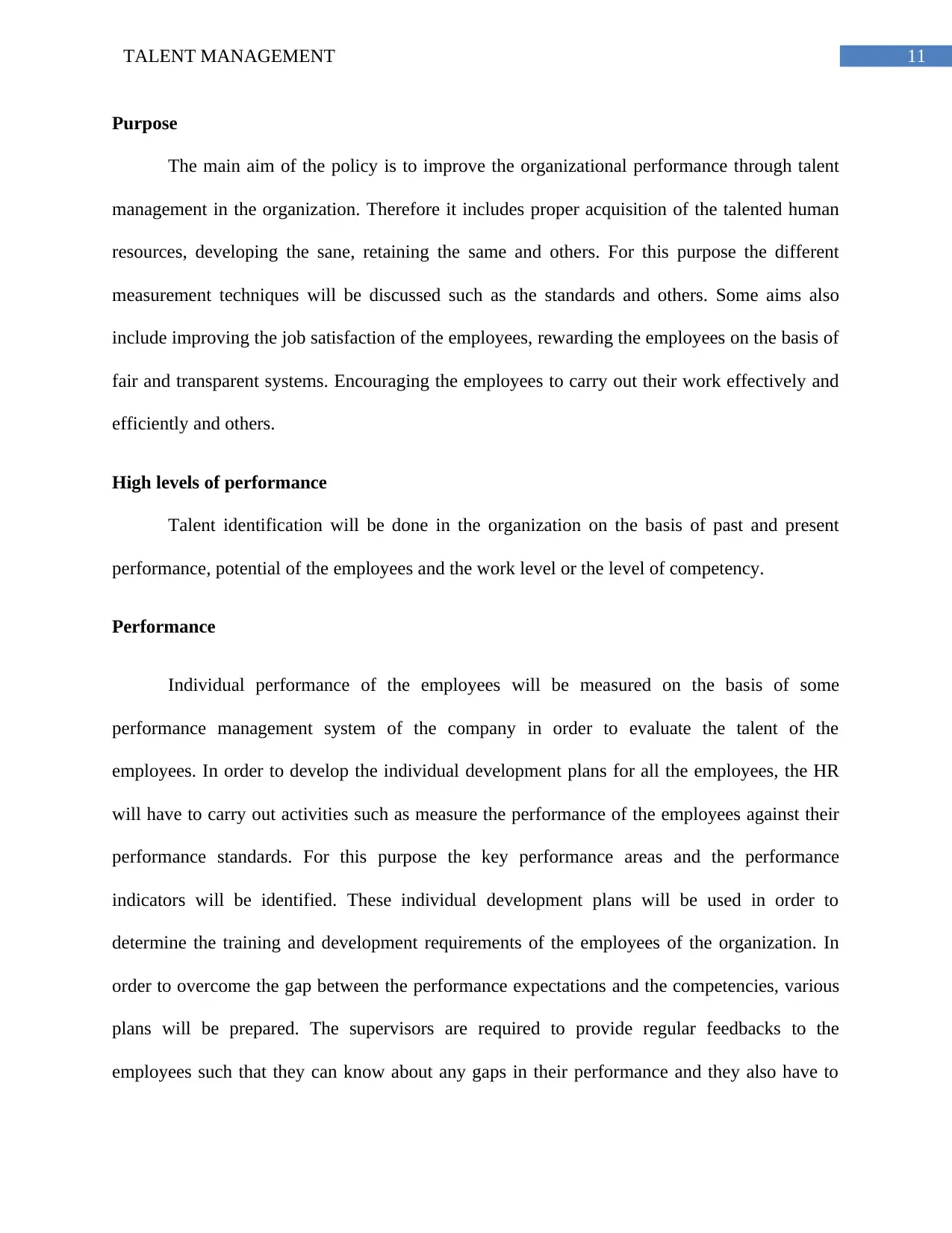
11TALENT MANAGEMENT
Purpose
The main aim of the policy is to improve the organizational performance through talent
management in the organization. Therefore it includes proper acquisition of the talented human
resources, developing the sane, retaining the same and others. For this purpose the different
measurement techniques will be discussed such as the standards and others. Some aims also
include improving the job satisfaction of the employees, rewarding the employees on the basis of
fair and transparent systems. Encouraging the employees to carry out their work effectively and
efficiently and others.
High levels of performance
Talent identification will be done in the organization on the basis of past and present
performance, potential of the employees and the work level or the level of competency.
Performance
Individual performance of the employees will be measured on the basis of some
performance management system of the company in order to evaluate the talent of the
employees. In order to develop the individual development plans for all the employees, the HR
will have to carry out activities such as measure the performance of the employees against their
performance standards. For this purpose the key performance areas and the performance
indicators will be identified. These individual development plans will be used in order to
determine the training and development requirements of the employees of the organization. In
order to overcome the gap between the performance expectations and the competencies, various
plans will be prepared. The supervisors are required to provide regular feedbacks to the
employees such that they can know about any gaps in their performance and they also have to
Purpose
The main aim of the policy is to improve the organizational performance through talent
management in the organization. Therefore it includes proper acquisition of the talented human
resources, developing the sane, retaining the same and others. For this purpose the different
measurement techniques will be discussed such as the standards and others. Some aims also
include improving the job satisfaction of the employees, rewarding the employees on the basis of
fair and transparent systems. Encouraging the employees to carry out their work effectively and
efficiently and others.
High levels of performance
Talent identification will be done in the organization on the basis of past and present
performance, potential of the employees and the work level or the level of competency.
Performance
Individual performance of the employees will be measured on the basis of some
performance management system of the company in order to evaluate the talent of the
employees. In order to develop the individual development plans for all the employees, the HR
will have to carry out activities such as measure the performance of the employees against their
performance standards. For this purpose the key performance areas and the performance
indicators will be identified. These individual development plans will be used in order to
determine the training and development requirements of the employees of the organization. In
order to overcome the gap between the performance expectations and the competencies, various
plans will be prepared. The supervisors are required to provide regular feedbacks to the
employees such that they can know about any gaps in their performance and they also have to
⊘ This is a preview!⊘
Do you want full access?
Subscribe today to unlock all pages.

Trusted by 1+ million students worldwide
1 out of 19
Related Documents
Your All-in-One AI-Powered Toolkit for Academic Success.
+13062052269
info@desklib.com
Available 24*7 on WhatsApp / Email
![[object Object]](/_next/static/media/star-bottom.7253800d.svg)
Unlock your academic potential
Copyright © 2020–2025 A2Z Services. All Rights Reserved. Developed and managed by ZUCOL.





